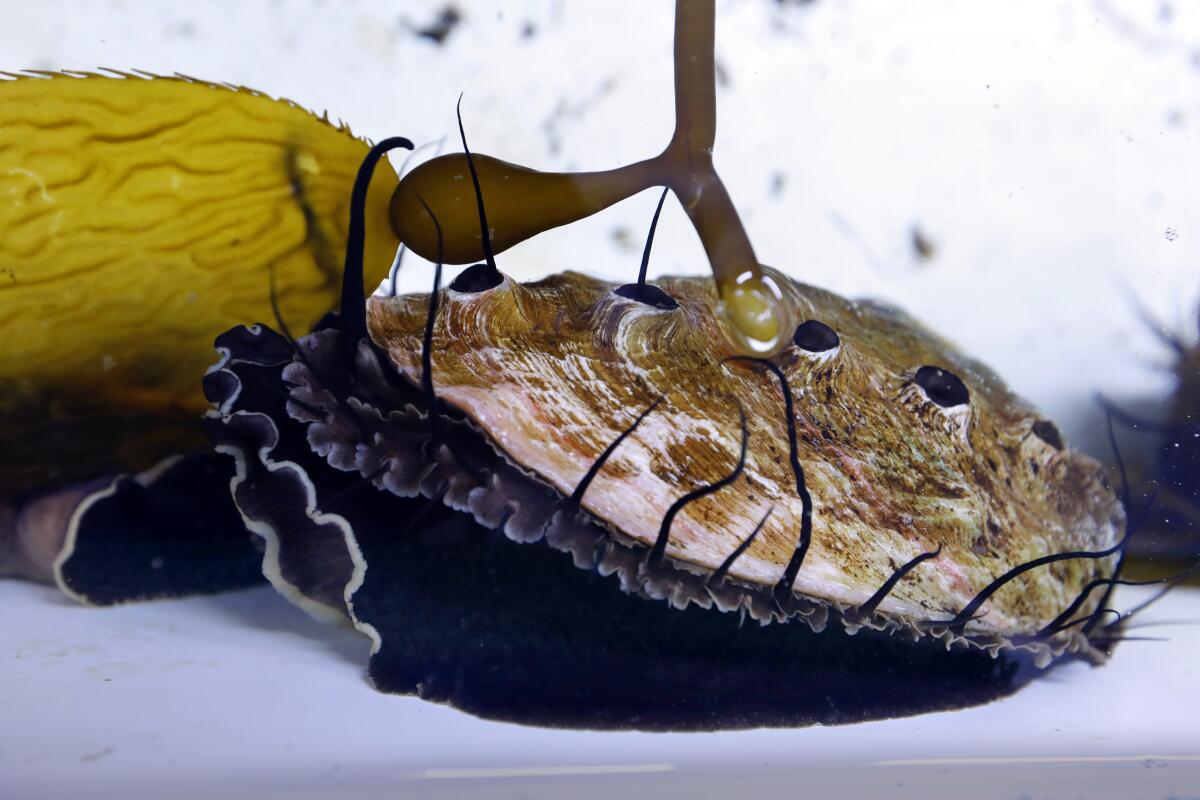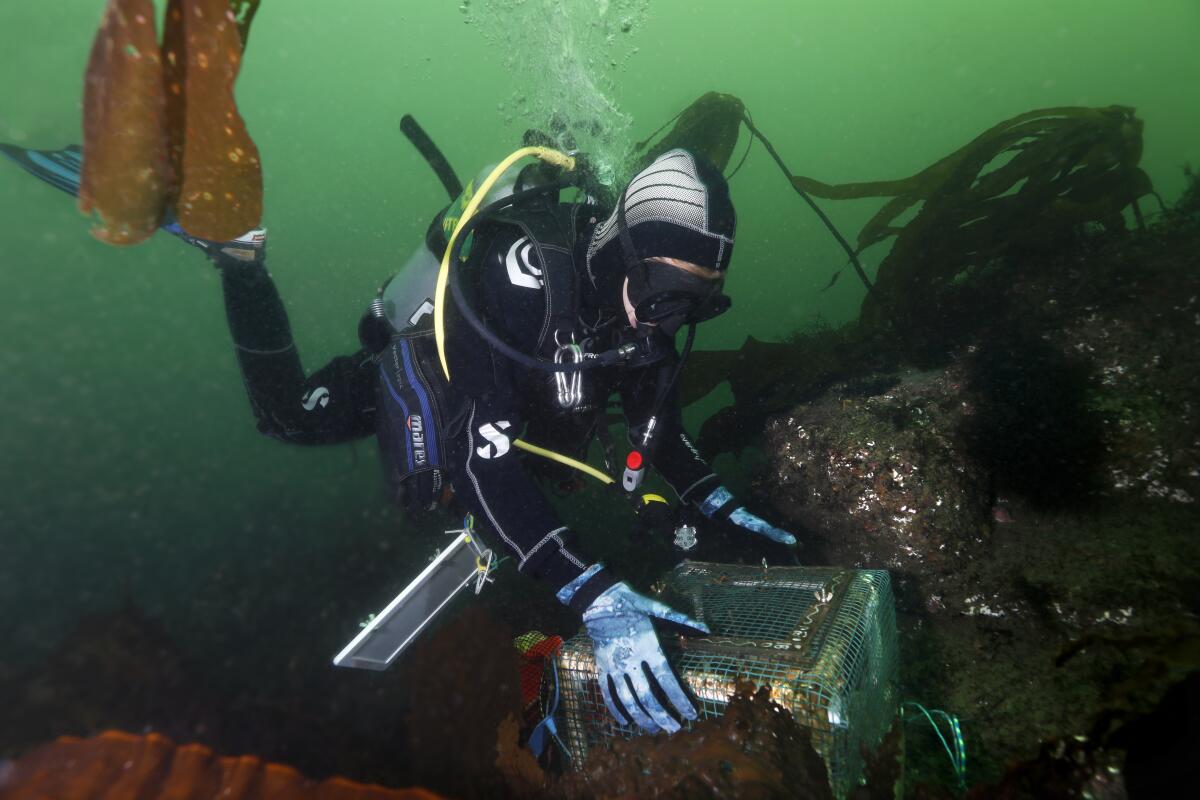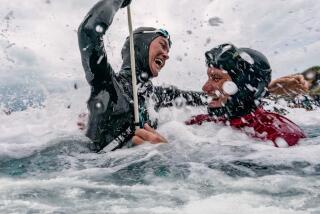Behind the Story: Tracking abalone in the lab, by boat and under the sea

- Share via
My job is to write about the wonders and challenges of our coast and oceans, but I’ll admit: Before this story, I had no idea what an abalone looked like.
They had vanished from the Southern California psyche long before I moved here. My closest encounters were the occasional news briefs about divers far, far north who died searching for one or arrested for taking too many. For the longest time, I imagined some mythical unicorn-like creature under the sea.
When I finally held one in my hand, I thought I was looking at a bumpy rock. Then I squealed as it sucked and slimed its way across my hand at a speed much faster than your typical snail. I found myself calling them cute and gushing the same words many abalone scientists have shared with me:
“Wow, look at its face. It has a face!”
It’s mind-boggling just how many people have dedicated their careers to saving these snails. You met some of them in today’s Column One, but so many more scientists and farmers and aquarists and divers helped tell this story. Their humor and love for abalone have stuck with me long after the quotes I scribbled into my notebook and the hours and hours we spent together on dive boats and in many a lab.
There’s Melissa Neuman at NOAA Fisheries, who spent years studying flounder but ultimately came out west for these gastropods. And David Witting, who everyone is pretty sure lies in bed just thinking about ways to engineer all things abalone. According to my shorthand notes, Lindsay Marks is “racing sea stars vs white abalone!!!” but actually is doing critical research on how fast white abalone react to predators — especially when they’ve spent most of their lives in a cushy lab.
Everyone seems to have an “abalone voice” when they’re talking to, or talking about, these derpy-looking creatures. One scientist tattooed the abalone’s entire life span, from larvae to adulthood, on her arm.
With Kristin Aquilino, the mother of abalone you met in the story, we were talking about abalone gonads one minute, her own life the next: Her husband, who grew up diving for red abalone, proposed with an abalone pearl that he found near where they first met. The red shells collected from those memorable days together are now playthings in the hands of their 4-year-old daughter, who gives them food and medicine and frets about “my abalone” getting sick.
One day, Aquilino dreams, she’ll be able to take her children diving in an ocean filled with white abalone. She herself has never seen one in the wild.
Those who have are witnesses to our warming ocean. I’ll never forget meeting Terry Herzik and Gary Thompson, two dive fisherman in their 70s who often lend their boat to scientists. They’ve seen how much the seafloor has changed since they first started fishing in 1975 and jumped at the chance to help the abalone efforts.
They see the kelp recovering, the green abalone coming back. And now, they can even imagine an ocean brimming again with reds and whites.
“For so many years, I had been taking from the ocean,” Herzik said. “Now I can help give back.”
I thought of these words as I tracked down history books and stories of the old abalone days. (One book, “More than Nine Lives,” is so out of print that a copy goes for $225 on EBay. The Scripps Institution of Oceanography, if you’re interested, has a library copy.)
I discovered that in the 1850s, the abalone in Monterey Bay supported Chinese immigrants who could send the dried baoyu home as prized delicacies. Then came the Japanese fishermen, who pioneered new dive technology that allowed them to stay underwater for hours at a time collecting awabi.
Diving today is admirable — with 40-pound nitrox tanks, dry suits, advanced timers and calculators. The Bay Foundation scientists, like their many partners, have geared up in the middle of winter to check on the abalone in freezing waters. They’ve anxiously waited out rain and wind and unforgiving ocean swells.
They’ve spent days hunched over thousands of abalone — measuring, counting and tagging each one with patience and care. I watched Parker House paint a tiny bright blue dot and tweeze numbered tags onto so many little abalone. Laid out on a damp towel, they kept clinging on to each other before the paint dried and I couldn’t help but wonder just how helpless they would be in the ocean.
You never know which one you’re tagging might be the One That Lives, he said with dramatic flourish. His voice dropped a few decibels and became more somber: It would mean so much if even four or five survived long enough to become a full-grown adult.
“Will it be you, Okinawa Blue 55?” he said, holding up the 55th snail he had tagged that morning. “Be strong, little guy, maybe I will see you again.”

The ocean covers more than 70% of the Earth’s surface, but we know so little and see so little of this vast part of the world. Carolyn Cole, who shot the photos and videos for this story, followed the abalone all the way down to the seafloor. She learned how to dive more than 75 feet with nitrox, shouldering her (very!) heavy camera equipment and finding ways to show more readers this planet we all share.
The world keeps getting hotter, the ocean absorbing so much of this heat. The sea is rising, and our own homes and ways of life are under threat. Underwater, these ecosystems are also changing with each storm and season. Like the endangered abalone, every living creature down there means something. Every life-encrusted ridge and healthy tower of kelp swaying with the current is a beautiful indicator of life and resilience under the sea.
Carolyn and I explored everything with awe, and we are excited to finally show you — with photos, with underwater videos, with history and the research and devotion of so many scientists — a window into this colorful world so deep beneath the surface.
More to Read
Sign up for Essential California
The most important California stories and recommendations in your inbox every morning.
You may occasionally receive promotional content from the Los Angeles Times.














